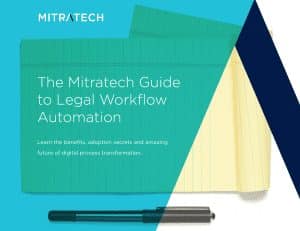Legal Workflow Automation Use Cases: Customization Must Come First
Legal automation can be disruptively beneficial or disruptively disastrous for legal departments. One factor that makes the difference? Whether or not an automation product empowers users to craft their own solutions.
Whether for process automation, predictive analytics, e-billing, any legal automation solution only succeeds when user needs and user experiences come first. In his book Dreaming in Code: Two Dozen Programmers, Three Years, 4,732 Bugs, and One Quest for Transcendent Software, Scott Rosenberg coined a meme-worthy quote about the role of software development in driving disruption: “The revolution has to be customised.”
This was in the pre-SaaS era, and he was writing about the work of programmers and software architects, not end users. But the point still holds today, as does another observation he offered:
“Software is easy to make, except when you want it to do something new. And then, of course, there is a corollary: The only software that’s worth making is software that does something new.”
In today’s Legal Operations and legal IT environment, we’d make a small but important edit:
The only software that’s worth making is software that lets the user do something new.
Legal automation of workflows: Customization is key
Legal workflow automation is already proving to be a cornerstone of legal tech ecosystems, for many reasons. A particular solution’s ability to provide user customization of processes to suit Legal Ops needs is one of them.
A workflow solution adopter may start small with a pilot use case. Their ability to build a customized workflow, whether from scratch or by modifying an existing template, is key to that pilot’s success as a proof-of-concept.
Once it’s been proven, the user will invariably look for other instances where legal automation can be applied. The pilot process may be customized for other workflows, while all-new workflows are designed.
Our own Emily Bogin, an Account Manager with long experience working with users of our TAP Workflow Automation product, has seen this in action:
“Workflows often grow with Legal Departments. A Legal Department might start with an NDA workflow, and after 3 months of piloting, decide to expand it to include other contract types. Or maybe they will expand the NDA to be available in other languages, too. Or maybe they will modify the approval process, or the wording of the notifications.”
As Ben Bogin, Senior Product Manager for TAP, puts it,
“It’s easy to start with the low-hanging fruit, and as more and more people wind up using a proven product, just tack on more use cases. We’ve even seen legal teams gift workflows to other teams. It’s a great way to show other people the benefits of legal automation, and it’s a gift that keeps on giving.”
Another benefit of this expansion? If the legal automation solution is truly easy to learn and use, more users will collaborate and co-innovate among themselves or with the provider’s support team. The result, in our experience? New use cases where the inventiveness of these users goes takes the product far beyond what its original product managers and programmers could have imagined.
That’s one reason why a solution provider should launch a community co-innovation center where Legal Ops users can share their own workflow use cases, or browse the work of others. This helps individual users and powers the growth and skills of the entire Legal Operations community.
A use cases sampler
Here are just some of the legal workflow use cases where legal automation has delivered faster, more precise execution and quick efficiency gains.
Legal Service Request Portal
A workflow that’s designed as a “front end” for users looking to have interactions for the legal department, and can integrate online self-service forms, FAQs, examples, and more.
Self-Service NDA Request
A standalone workflow that lets an employee or other end user request an ad hoc NDA. The NDA can be approved or rejected via automatic routing to multiple approvers and reviewers.
Gifts & Entertainment Submission
Workflow (that can be tied into a Policy Management solution like PolicyHub) permitting a user to make a disclosure about a gift they’ve received. The corporate policy is embedded into the workflow, allowing the user to get a better understanding as to what is and is not acceptable.
Conflict of Interest
In this workflow, a user can disclose any situation or information that could potentially be flagged as a conflict of interest. Different approval routings for different types of potential conflicts ensure there’s proper coverage in deciding if a conflict exists.
Policy Query
A simple workflow that lets a user ask questions about a specific policy and whether or not it will apply to an employee.
Procurement Process
Built either for a generic procurement process or customized to a department or company’s particular requirements.
Policy Exception
Workflow allowing an employee to submit a claim that a particular policy doesn’t apply to them. For example: An employee with a broken arm can submit a claim to the compliance department about how a Personal Protective Equipment Policy won’t apply to them for the duration of their injury.
Outside Counsel Engagement
Allowing a legal department to get timely updates and documentation from outside counsel on any existing matters.
New Contract Request
Legal automation of the steps involved in generating a legal contract, whether they’re simple tasks or a complex Contract Lifecycle Management (CLM) workflow.
Matter Management Intake
Users can design, track and manage a matter management workflow; legal and corporate best practices can be embedded in it to ensure compliance and minimize risk, and managers can gain centralized visibility into all matter management processes.
Ready to see the latest innovations in legal tech?
Mitratech's leaders will be onsite to show you what's new – at CLOC Vegas 2019, May 14-16th.




